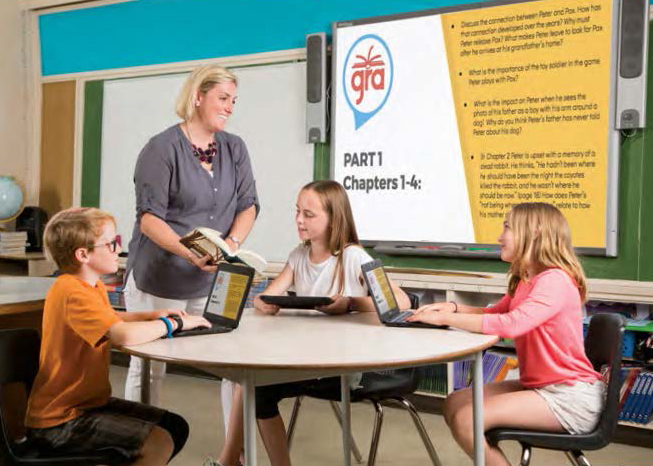Share this page
A middle-school class in Zurich, Ont., takes part in the Global Read Aloud project and opens the door to respectful communication.
By Stefan Dubowski
Photo: Peter Power

The Challenge: Help students communicate effectively and respectfully in the internet era.
The Solution: Take part in the online Global Read Aloud project (theglobalreadaloud.com), and use Twitter (twitter.com), Padlet (padlet.com) and other technologies to communicate with classes around the world.
Lessons Learned: Caroline Thuss, OCT, a Grade 6 and 7 teacher at St. Boniface Catholic School in Zurich, Ont., wanted to help students learn to communicate with other people, no matter how far away or how different their cultures and perspectives may be.
So this OCT and her class participated in the Global Read Aloud project. During this multi-week initiative, teachers around the world read the same book with their students. Then they use web technologies to connect with other classes.
The idea is to introduce youngsters to people elsewhere through a shared experience, with an eye toward helping them respect different points of view.
For the fall of 2016, Thuss and her class read Pax by Sara Pennypacker. It’s the story of a boy named Peter and his pet fox, Pax. With war approaching, Peter is forced to release Pax into the wild, and the boy is sent to live at his grandfather’s house hundreds of miles away. But Peter misses Pax, and he sets out to reunite with his pet.
Thuss and her students read about five chapters a week. Through the class Twitter account, they followed the hashtag #PaxSlowChat, where participating teachers and classes from the United States, New Zealand, Singapore and elsewhere posted ideas about the story, addressing questions such as: How do you think Peter got the fox for a pet? Do you think Peter regrets leaving home? Will Pax be able to adapt to the wild?
Thuss’s students would come up with their own individual responses, jotting their answers in school-provided Chromebooks, usually using online word-processing software such as Google Docs or Padlet. Thuss would review the students’ responses and narrow them down to a short list of exceptionally good answers. She would discuss the list with the class to decide which ones to tweet out. Then a student, under Thuss’s close supervision, would post the answers on Twitter. Each week, a different student had that privilege.
The class also connected directly with a school in Alaska to further those discussions. Using Padlet, Thuss’s students posed questions about the story’s content and how it was written. The children at the other school would open the same Padlet and write back, generating thoughtful dialogue.
Observations: By reading tweets from around the world, Thuss’s students learned that different points of view are shaped by the culture and society in which people live. “We’re examining a book, but it’s not just for a deeper understanding of literature — we’re expanding our vision.”
The College’s professional advisory Use of Electronic Communication and Social Media oct-oeeo.ca/ecomm guides members’ professional judgment in the use of technology.
Helpful Hint: Prepare early, says Caroline Thuss, OCT. The first year she participated in Global Read Aloud (which kicks off in October), she didn’t have enough time at the beginning to set up a direct connection with a class elsewhere.
What You’ll Need: Access to Global Read Aloud, a class Twitter account, online word-processing software such as Google Docs or Padlet
Steps: